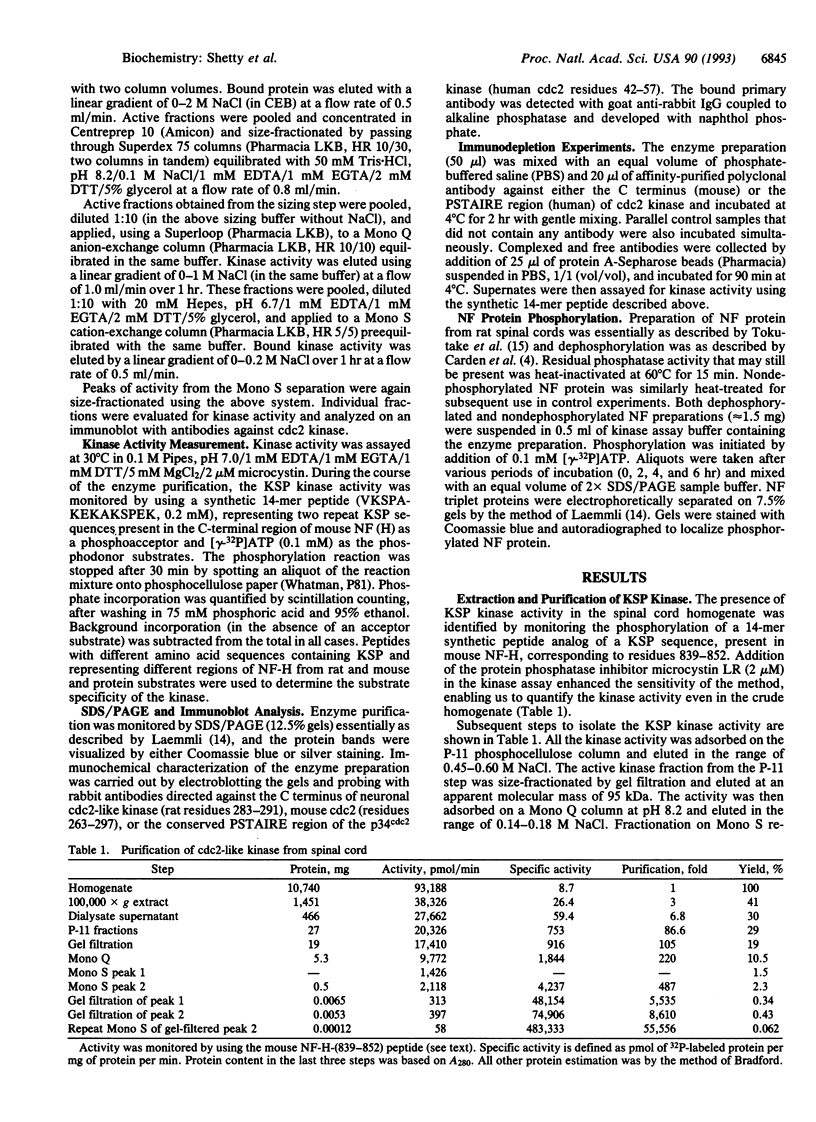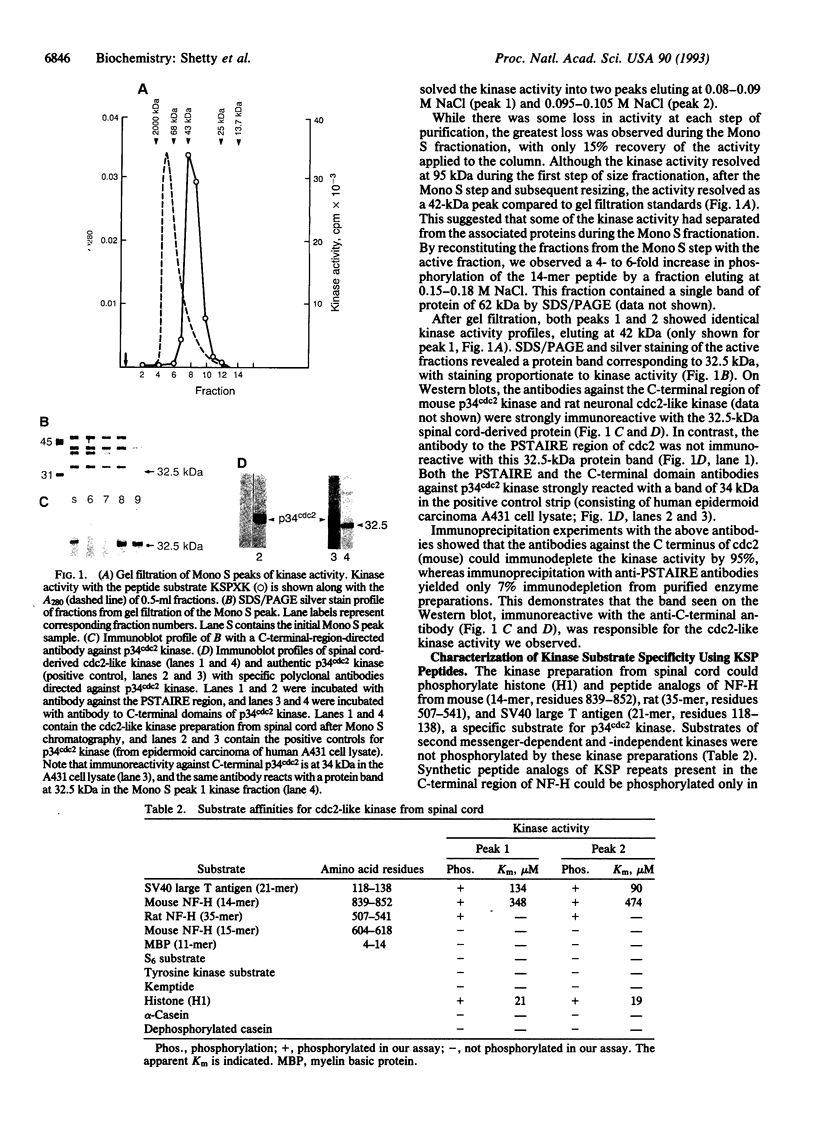Abstract
A protein kinase that phosphorylates a specific KSP sequence [K(S/T)PXK], which is abundant in high molecular weight neurofilament (NF) proteins, was identified and isolated from rat spinal cord. Characterization of this enzyme activity revealed a close relationship with p34cdc2 kinase with respect to its molecular mass (32.5 kDa by SDS/PAGE) and substrate specificities. It could phosphorylate a synthetic peptide analog of the simian virus 40 large tumor antigen, reportedly a specific substrate for p34cdc2 kinase. Histone (H1) and peptide analogs of the KSP sequence present in the C-terminal end of rat and mouse neurofilament proteins were phosphorylated. This kinase did not phosphorylate alpha-casein and peptide substrates of other known second messenger-dependent or -independent kinases. Dephosphorylated rat NF protein NF-H was strongly phosphorylated by the purified enzyme; NF proteins NF-M and native NF-H, but not NF-L, were slightly phosphorylated. Studies on synthetic peptide analogs of KSP repeats with substitution of specific residues, known to be present in the C-terminal regions of NF-H, revealed a consensus sequence of X(S/T)PXK, characteristic of the p34cdc2 kinase substrate. On Western blots, the enzyme was immunoreactive with antibody against the C-terminal end of cdc2 kinase (mouse) and neuronal cdc2-like kinase from rat but not with an antibody against the conserved PSTAIRE region of the p34cdc2 kinase. The antibody against the C-terminal end of cdc2 kinase could immunoprecipitate (immunodeplete) the purified kinase activity. Since the adult nervous system is composed primarily of postmitotic cells, the present observations indicate a nonmitotic role for this cdc2-like kinase activity. The effective phosphorylation of NF-H by this kinase suggests a function in axonal structure.
Full text
PDF




Images in this article
Selected References
These references are in PubMed. This may not be the complete list of references from this article.
- Carden M. J., Trojanowski J. Q., Schlaepfer W. W., Lee V. M. Two-stage expression of neurofilament polypeptides during rat neurogenesis with early establishment of adult phosphorylation patterns. J Neurosci. 1987 Nov;7(11):3489–3504. doi: 10.1523/JNEUROSCI.07-11-03489.1987. [DOI] [PMC free article] [PubMed] [Google Scholar]
- Chin S. S., Liem R. K. Transfected rat high-molecular-weight neurofilament (NF-H) coassembles with vimentin in a predominantly nonphosphorylated form. J Neurosci. 1990 Nov;10(11):3714–3726. doi: 10.1523/JNEUROSCI.10-11-03714.1990. [DOI] [PMC free article] [PubMed] [Google Scholar]
- Goldman J. E., Yen S. H. Cytoskeletal protein abnormalities in neurodegenerative diseases. Ann Neurol. 1986 Mar;19(3):209–223. doi: 10.1002/ana.410190302. [DOI] [PubMed] [Google Scholar]
- Guan R. J., Hall F. L., Cohlberg J. A. Proline-directed protein kinase (p34cdc2/p58cyclin A) phosphorylates bovine neurofilaments. J Neurochem. 1992 Apr;58(4):1365–1371. doi: 10.1111/j.1471-4159.1992.tb11351.x. [DOI] [PubMed] [Google Scholar]
- Hayes T. E., Valtz N. L., McKay R. D. Downregulation of CDC2 upon terminal differentiation of neurons. New Biol. 1991 Mar;3(3):259–269. [PubMed] [Google Scholar]
- Hellmich M. R., Pant H. C., Wada E., Battey J. F. Neuronal cdc2-like kinase: a cdc2-related protein kinase with predominantly neuronal expression. Proc Natl Acad Sci U S A. 1992 Nov 15;89(22):10867–10871. doi: 10.1073/pnas.89.22.10867. [DOI] [PMC free article] [PubMed] [Google Scholar]
- Hisanaga S., Kusubata M., Okumura E., Kishimoto T. Phosphorylation of neurofilament H subunit at the tail domain by CDC2 kinase dissociates the association to microtubules. J Biol Chem. 1991 Nov 15;266(32):21798–21803. [PubMed] [Google Scholar]
- Laemmli U. K. Cleavage of structural proteins during the assembly of the head of bacteriophage T4. Nature. 1970 Aug 15;227(5259):680–685. doi: 10.1038/227680a0. [DOI] [PubMed] [Google Scholar]
- Lee V. M., Otvos L., Jr, Schmidt M. L., Trojanowski J. Q. Alzheimer disease tangles share immunological similarities with multiphosphorylation repeats in the two large neurofilament proteins. Proc Natl Acad Sci U S A. 1988 Oct;85(19):7384–7388. doi: 10.1073/pnas.85.19.7384. [DOI] [PMC free article] [PubMed] [Google Scholar]
- Lees J. F., Shneidman P. S., Skuntz S. F., Carden M. J., Lazzarini R. A. The structure and organization of the human heavy neurofilament subunit (NF-H) and the gene encoding it. EMBO J. 1988 Jul;7(7):1947–1955. doi: 10.1002/j.1460-2075.1988.tb03032.x. [DOI] [PMC free article] [PubMed] [Google Scholar]
- Lew J., Winkfein R. J., Paudel H. K., Wang J. H. Brain proline-directed protein kinase is a neurofilament kinase which displays high sequence homology to p34cdc2. J Biol Chem. 1992 Dec 25;267(36):25922–25926. [PubMed] [Google Scholar]
- Lewin B. Driving the cell cycle: M phase kinase, its partners, and substrates. Cell. 1990 Jun 1;61(5):743–752. doi: 10.1016/0092-8674(90)90181-d. [DOI] [PubMed] [Google Scholar]
- Meyerson M., Enders G. H., Wu C. L., Su L. K., Gorka C., Nelson C., Harlow E., Tsai L. H. A family of human cdc2-related protein kinases. EMBO J. 1992 Aug;11(8):2909–2917. doi: 10.1002/j.1460-2075.1992.tb05360.x. [DOI] [PMC free article] [PubMed] [Google Scholar]
- Minami Y., Sakai H. Dephosphorylation suppresses the activity of neurofilament to promote tubulin polymerization. FEBS Lett. 1985 Jun 17;185(2):239–242. doi: 10.1016/0014-5793(85)80914-5. [DOI] [PubMed] [Google Scholar]
- Napolitano E. W., Chin S. S., Colman D. R., Liem R. K. Complete amino acid sequence and in vitro expression of rat NF-M, the middle molecular weight neurofilament protein. J Neurosci. 1987 Aug;7(8):2590–2599. [PMC free article] [PubMed] [Google Scholar]
- Seger R., Ahn N. G., Boulton T. G., Yancopoulos G. D., Panayotatos N., Radziejewska E., Ericsson L., Bratlien R. L., Cobb M. H., Krebs E. G. Microtubule-associated protein 2 kinases, ERK1 and ERK2, undergo autophosphorylation on both tyrosine and threonine residues: implications for their mechanism of activation. Proc Natl Acad Sci U S A. 1991 Jul 15;88(14):6142–6146. doi: 10.1073/pnas.88.14.6142. [DOI] [PMC free article] [PubMed] [Google Scholar]
- Shneidman P. S., Carden M. J., Lees J. F., Lazzarini R. A. The structure of the largest murine neurofilament protein (NF-H) as revealed by cDNA and genomic sequences. Brain Res. 1988 Nov;464(3):217–231. doi: 10.1016/0169-328x(88)90028-9. [DOI] [PubMed] [Google Scholar]
- Sihag R. K., Nixon R. A. Phosphorylation of the amino-terminal head domain of the middle molecular mass 145-kDa subunit of neurofilaments. Evidence for regulation by second messenger-dependent protein kinases. J Biol Chem. 1990 Mar 5;265(7):4166–4171. [PubMed] [Google Scholar]
- Soppet D. R., Beasley L. L., Willard M. B. Evidence for unequal crossing over in the evolution of the neurofilament polypeptide H. J Biol Chem. 1992 Aug 25;267(24):17354–17361. [PubMed] [Google Scholar]
- Sternberger N. H., Sternberger L. A., Ulrich J. Aberrant neurofilament phosphorylation in Alzheimer disease. Proc Natl Acad Sci U S A. 1985 Jun;82(12):4274–4276. doi: 10.1073/pnas.82.12.4274. [DOI] [PMC free article] [PubMed] [Google Scholar]
- Tokutake S., Hutchison S. B., Pachter J. S., Liem R. K. A batchwise purification procedure of neurofilament proteins. Anal Biochem. 1983 Nov;135(1):102–105. doi: 10.1016/0003-2697(83)90736-4. [DOI] [PubMed] [Google Scholar]
- Wible B. A., Smith K. E., Angelides K. J. Resolution and purification of a neurofilament-specific kinase. Proc Natl Acad Sci U S A. 1989 Jan;86(2):720–724. doi: 10.1073/pnas.86.2.720. [DOI] [PMC free article] [PubMed] [Google Scholar]
- Xiong Y., Zhang H., Beach D. D type cyclins associate with multiple protein kinases and the DNA replication and repair factor PCNA. Cell. 1992 Oct 30;71(3):505–514. doi: 10.1016/0092-8674(92)90518-h. [DOI] [PubMed] [Google Scholar]




